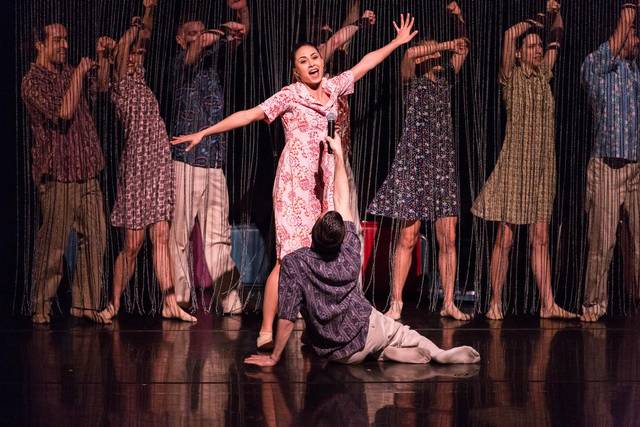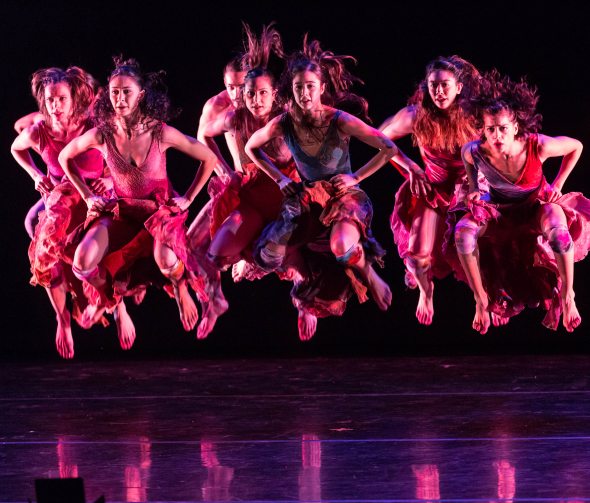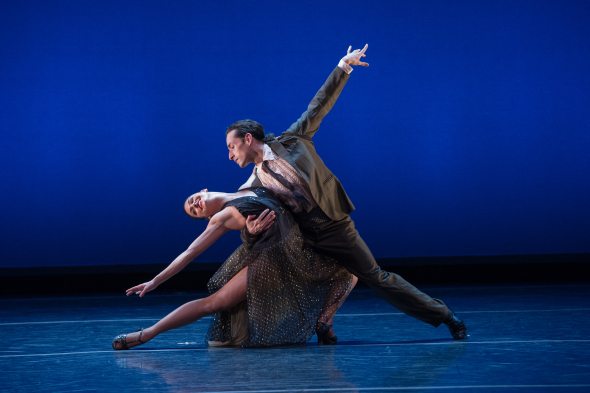

Ballet Hispanico is celebrating 45 years of repertory and returning to the Joyce Theater April 5th-10th with many exciting works, including Gustavo Ramírez Sansano's Flabbergast, Ramón Oller's Bury Me Standing, and Pedro Ruiz's Club Havana. Dedicated to reflecting the ever-changing diversity of Latino cultures, the internationally renowned Ballet Hispanico, led by Artistic Director and CEO Eduardo Vilaro, presents rich and poignant pieces that prove to be timeless with culturally specific yet universal themes. Working to shed a stereotypical view of Latino culture, the company aims to show the public that they aren’t just Hispanic: they are embracing the culture with the goal to share these stories as individuals. I spoke with two company members, Christopher Bloom and Melissa Fernandez, to get an inside scoop on what to expect for this season. Both had a lot to say about their own experiences and perspectives, as well as the cultural and political relevance of the works today.
I read that Flabbergast, choreographed by Gustavo Ramírez Sansano, “exposes with humor our stereotypes and preconceived ideas about new and foreign places.” How does these ideas come across on stage through humor?
Melissa Fernandez: I think the ideas [Gustavo] is exploring by incorporating a humor to it, reads well on stage especially when combined with the set design and the costumes and the lighting. Gustavo has a great way of creating an atmosphere. It’s as if you’re looking from the outside through a little key hole, and you peer inside and see this story unfold.
Christopher Bloom: There is a theme throughout the work of the characters experiencing newness and being somewhat taken aback. There’s an image where a bunch of people are travelers and all going to a new place—all carrying suitcases. There is an instance of a duet coming together for the first time in a dream, and it’s awkward. They’re not being cool with their flirting and with their introductions to each other so they’re just going nuts over each other. In the very beginning of the piece, we’re all arrayed on stage and we were told to give the impression that we’re still drunk from the night before. There’s a sound cue and we all shoot awake as if we are at work and our boss comes in, and we’re like “I’m up! I’m good! I’m fine…everything’s cool. I am completely sober.” I think it explores [newness], rather than doing it on a grand scale, in very small and intimate examples.
It sounds very fun to perform.
MF: It is. Honestly, it’s one of those pieces where you have to expend a lot of energy because all of [Gustavo’s] movement is so large and grounded, but it’s one of those pieces that you finish and feel satisfied because you genuinely enjoyed it.

Another piece you'll be performing, Bury Me Standing, is choreographed to traditional Gypsy melodies. What are these musical traditions and how do they enhance the work?
MF: Bury Me Standing is choreographed by Ramón Oller—a Spanish choreographer very well known in Spain especially in the '80s during his peak. He created this piece to explore the trajectory (you could say) of the Romani Gypsies, [but] it’s a mix of all Gypsies. The music that he uses is very traditional; it has those elements of the Romani Gypsies, Spanish Gypsies, Arabic Gypsies. So when you hear the music, you are automatically transported to these lands. For example, the piece starts with a caravan of Gypsies traveling across the land and the music sounds like a wagon turning. Then it evolves into a more delicate woman’s soprano voice singing. As it continues it increases in intensity, with the vocalist and also with the dancers. I think that the music really helps the dancers integrate themselves more artistically into the piece.
CB: My understanding of the music is that it’s a representation of the broad spectrum of varieties of European traveling people that exist. There’s strands of traveling people that came from Romania, there’s stands that came from North Africa, from India and the Balkans, and they end up in various places in Europe and Spain. So with the music, we touch all of those places. There are Indian vibes, Balkan vibes, Flamenco influences within different pieces within the work. I think it is meant to encompass the entire world of the traveling Gypsies rather than just one single type.
It sounds like you both have a solid grasp on this particular history. Is this a history you were already familiar with or did you learn throughout the process?
CB: I’ve known a little bit. In an effort to inform myself about the work we’re doing, I have done further research about where Gypsies come from and what influences the various cultures, because we have a tendency to say, “Gypsies” and think that that somehow covers the issue, but the thing is, they are a really broad and diverse groups of people. When we talk about Gypsies, we’re talking about many different people from many different places. We’re also talking about small groups, and groups develop differently when in isolation, which is essentially what happens. It was very interesting to learn about the many different varieties of traveling people that exist and what part of the various Gypsy experiences we are attempting to portray.
Does the movement vocabulary call back to these traditions and this variety of culture as well?
CB: It does. There are various styles of Flamenco integrated into the work. There is the more Spanish Flamenco and the more Romani Flamenco… There’s also a very strong strain of American modern dance as well as balletic movement. Not to say that ballet is from any Gypsy culture, or modern dance. That would be wrong. (Laughs.) [There are the] main elements we used from the actual cultures; then we used movement that is not from the actual cultures in order to say more things.
MF: When you compare it to the other pieces we are performing, you’ll see that it’s very different. All the pieces are very distinct from one another, but this piece requires a lot of technique—a lot of modern technique. But also, in order for it to convey any emotion, we really have to be in tune with the music as a unit, as an ensemble. [Really investing in the music] is what allows me to create my character.

This piece was choreographed almost 20 years ago. What cultural or political significance does this piece have for an audience in 2016?
CB: Well, there is the element that it is an excellent work. It is rich to perform--rich for the performers, rich for the audience. But something that makes an impression in these current times is, to boil it down, if we are doing a piece about traveling people, what we’re doing a piece about is dispossessed people--people who have been uprooted from whatever home that they knew. There are a lot of people like that in the world right now. There’s all kinds of refugees coming from many places looking for homes, looking for places to stay. The story of European traveling people is that they were ostracized everywhere they went, so they became insular and became their own tribes outside of the societies of the areas that they lived. So hopefully that doesn’t happen now. But it’s almost an allegorical metaphor for what could happen if we don’t handle the crises that we’re having with refugees in various parts of the world right now.
MF: I was recently in Spain and there were signs everywhere saying, “Refugees Welcome From Syria.” It made me think how even 20 years later this is a piece that has to do with a topic that is so relevant. I’m a Cuban-American. When my parents had to leave Cuba we established ourselves in the US, so growing up you hear about these things, but not until you actually see for yourself can you actually empathize. I think now, with this group of dancers (who are relatively young) bringing this piece back to life means a lot because we can incorporate, not only artistically and technically the dance knowledge that we’re required, but also knowledge of the world and our social awareness. That, to me, make a piece more rich. So far when we’ve performed it elsewhere people really do feel the intensity of it, whether they connect to the story of the Gypsies or the need to belong as a minority in a new country.
Club Havana is another older piece, choreographed in 2000 by Pedro Ruiz. Melissa, as a Cuban-American can you shed some light on and what this piece has to offer us now in our current political and cultural climate?
MF: Club Havana has been around for 15 years. I relate to it because it is my culture—the Cuban culture—and I think the music and the rhythms [like Salsa or Mambo] are so innate in the Cuban culture that no matter when you present them, they are going to be loved and cherished. This piece, Club Havana, really demonstrates [the Cuban people’s passion and sensuality], but you also see the Cuban people as a lively and joyous people regardless of the trials and tribulations they have faced. Mind you, Club Havana takes place in the 1950s before the [Cuban] revolution, so it’s a different kind of era and mentality. But the ideas of celebration, being who you are, and living it up are still true today.
Ballet Hispanico perform at the Joyce, April 5-10.